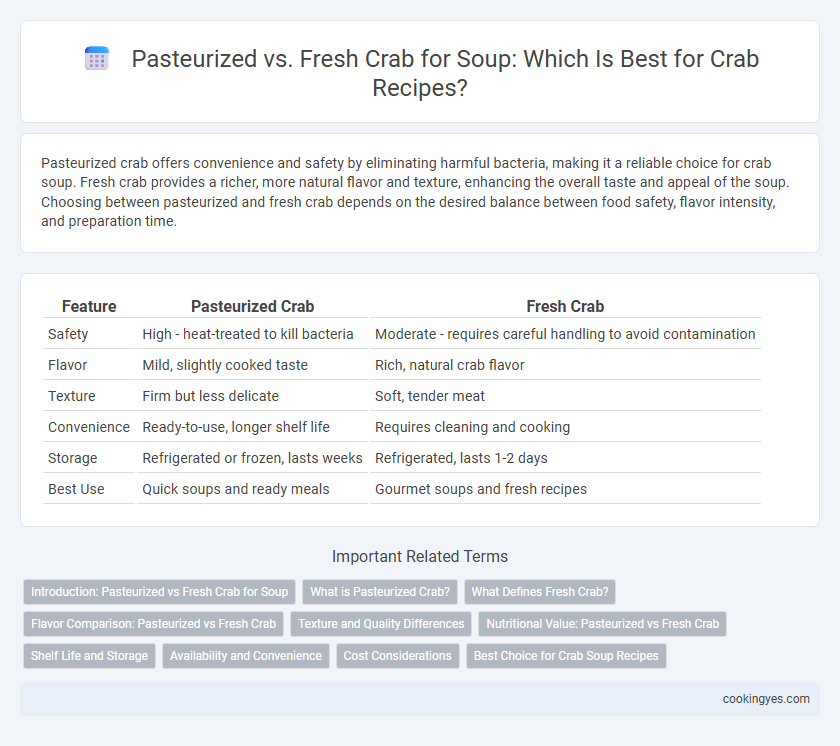Pasteurized crab offers convenience and safety by eliminating harmful bacteria, making it a reliable choice for crab soup. Fresh crab provides a richer, more natural flavor and texture, enhancing the overall taste and appeal of the soup. Choosing between pasteurized and fresh crab depends on the desired balance between food safety, flavor intensity, and preparation time.
Table of Comparison
| Feature | Pasteurized Crab | Fresh Crab |
|---|---|---|
| Safety | High - heat-treated to kill bacteria | Moderate - requires careful handling to avoid contamination |
| Flavor | Mild, slightly cooked taste | Rich, natural crab flavor |
| Texture | Firm but less delicate | Soft, tender meat |
| Convenience | Ready-to-use, longer shelf life | Requires cleaning and cooking |
| Storage | Refrigerated or frozen, lasts weeks | Refrigerated, lasts 1-2 days |
| Best Use | Quick soups and ready meals | Gourmet soups and fresh recipes |
Introduction: Pasteurized vs Fresh Crab for Soup
Pasteurized crab offers enhanced safety and longer shelf life due to heat treatment that eliminates harmful bacteria, making it a convenient choice for soup preparation. Fresh crab provides a superior natural flavor and texture, delivering a more authentic and rich taste profile in soups but requires careful handling to maintain quality. Choosing between pasteurized and fresh crab depends on prioritizing convenience and safety versus optimal flavor and freshness in crab soups.
What is Pasteurized Crab?
Pasteurized crab undergoes a heat treatment process that kills harmful bacteria while maintaining its flavor and texture, making it safe for immediate use in soups. This processing method extends shelf life and offers consistent quality, unlike fresh crab, which requires careful handling and quick consumption to ensure safety. Pasteurized crab provides convenience and reliability, especially for recipes where safety and preservation are critical factors.
What Defines Fresh Crab?
Fresh crab is defined by its recent harvest, typically caught within 24 hours to ensure optimal flavor and texture. Unlike pasteurized crab, which undergoes heat treatment to extend shelf life, fresh crab retains its natural sweetness and delicate meat quality essential for a rich, authentic crab soup. Properly handling and storing fresh crab at cold temperatures preserves its freshness, making it superior for culinary uses.
Flavor Comparison: Pasteurized vs Fresh Crab
Fresh crab delivers a richer, more delicate flavor with natural sweetness and a tender texture, making it ideal for flavorful soups. Pasteurized crab, while safe and convenient, often has a milder taste and firmer texture due to heat treatment, which can slightly diminish the depth of flavor in soup. Choosing fresh crab enhances the overall taste profile and aromatic complexity of crab soup.
Texture and Quality Differences
Pasteurized crab offers a firmer texture and extended shelf life, making it convenient for consistent soup preparation. Fresh crab provides a delicate, tender texture with superior flavor complexity, enhancing the soup's overall quality. The choice between pasteurized and fresh crab impacts the mouthfeel and richness, with fresh crab typically preferred for gourmet recipes.
Nutritional Value: Pasteurized vs Fresh Crab
Fresh crab offers higher levels of essential nutrients like omega-3 fatty acids, vitamin B12, and zinc compared to pasteurized crab, which can experience nutrient degradation during heat processing. Pasteurization extends shelf life and ensures safety by eliminating harmful bacteria, but it may reduce the bioavailability of heat-sensitive vitamins and proteins crucial for immune support. For nutrient-rich crab soup, fresh crab preserves the maximum nutritional profile vital for health benefits, while pasteurized options provide convenience with moderate nutrient retention.
Shelf Life and Storage
Pasteurized crab typically has a longer shelf life than fresh crab due to the heat treatment that kills bacteria, allowing it to be stored unopened in the refrigerator for up to 14 days or frozen for several months without compromising safety. Fresh crab, however, must be consumed within 1 to 2 days when refrigerated at temperatures below 40degF (4degC), as it is highly perishable and prone to rapid spoilage. Proper storage of fresh crab involves keeping it chilled on ice and covered, while pasteurized crab requires less stringent conditions, making it more convenient for soup preparation and extended use.
Availability and Convenience
Pasteurized crab offers greater availability year-round due to its extended shelf life and widespread distribution in frozen or canned forms, making it a convenient choice for quick meal preparation. Fresh crab, though often preferred for its superior flavor and texture, is seasonal and typically requires immediate cooking, limiting its accessibility in some regions. Choosing pasteurized crab allows consistent stock for soup recipes without the need for urgent use, while fresh crab demands planning but enhances the overall taste experience.
Cost Considerations
Pasteurized crab typically costs more due to the processing and packaging required to ensure longer shelf life and food safety, making it a convenient option for soup preparation with reduced risk of spoilage. Fresh crab, although often less expensive per pound, may incur additional costs such as immediate refrigeration, quicker cooking times, and potential waste from spoilage if not used promptly. Careful budget planning should weigh the upfront cost difference against storage and preparation requirements to optimize expenses when choosing between pasteurized and fresh crab for soup.
Best Choice for Crab Soup Recipes
Fresh crab delivers the richest flavor and tender texture essential for gourmet crab soup recipes, preserving natural sweetness and enhancing broth depth. Pasteurized crab offers convenience and safety, but its milder taste and firmer texture can result in less flavorful soup. For authentic crab soup, fresh crab is the best choice, optimizing taste and culinary quality.
Pasteurized vs fresh crab for soup Infographic

 cookingyes.com
cookingyes.com